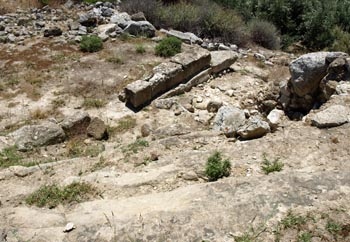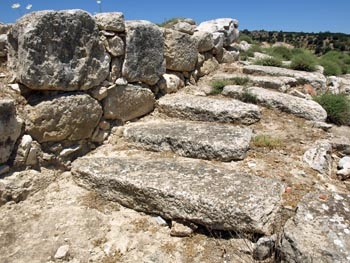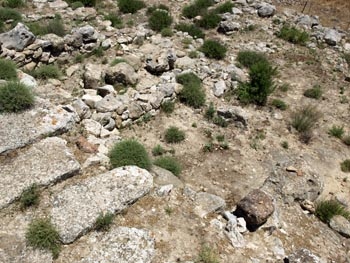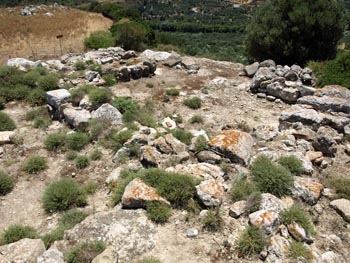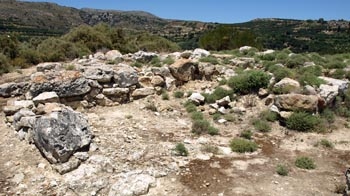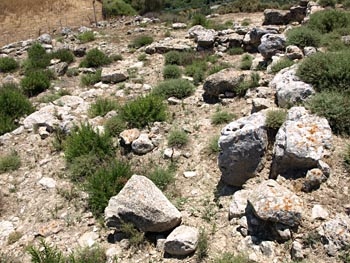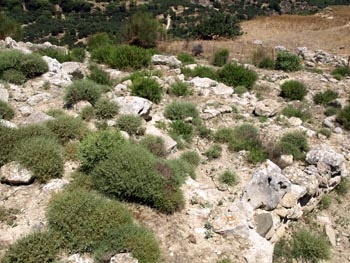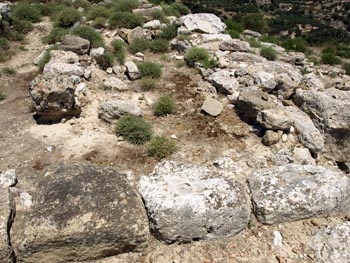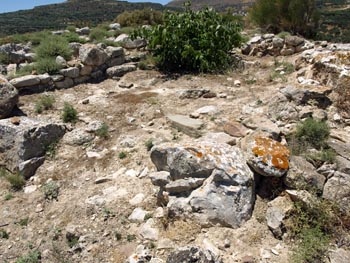A villa on four levels
The villa known as Ayios Georgios (also Agios or Hagios Georgios) is located on a hill called Prophitis Elias, not far from Praissos. The villa was built on four terraces and covers an area of 700 square metres. The north and west parts of the hill are very steep and part of the complex there has disappeared due to landslips. The building is not very well preserved, but the upper terraces have survived better than the lower ones.
The site was entered through the opening next to the west wall of Room A. It is thought that this room may have served as an anteroom for the complex, given the high quality of the masonry of this wall. Opposite room A, a chamber was cut in the rock and was probably unroofed. This seems also to have formed part of the entrance to the complex.
The lowest terrace -- the eastern part of the complex -- is the least well preserved. The next terrace up, rooms 7, 8, 9 and 10 (E, Z, H and Θ), show signs of a later phase of building. Unfortunately it is not possible to understand how it would have appeared because Early Christian burials have destroyed most of this part of the site.
The most important parts of the building stood on the top two terraces and each terrace comprised a series of rooms which were accessed from an open-air corridor on the East side. So the rooms on the second terrace were accessed from the corridor 11 and 12 (I, K) to their east. The rooms on the top terrace were served by a staircase from the south, of which nine steps remain in situ. At the top of the steps was a partly paved corridor which was the centre of the whole building complex. From here it was possible to reach the rooms on the top terrace and quite likely the first floor rooms of the buildings on the second terrace (13, 14, 15, 16, 17, 18, Λ, Μ, Ν, Ξ, Ο, Π).
As Lefteris Platon points out, "the quality of the construction of the rooms on the top terrace was the highest in the whole complex and it gives to this quarter the aspect of an independent unit. Its east facade, with the indentations to which the Minoans were much attached, was built with large, limestone blocks and would be very impressive to people climbing the two staircases. The rooms were spacious and communicated in couples through doors opening in the partition walls. The north and south ends of the top terrace building probably terminated in verandas, parts of which have disappeared down the slopes."
While pottery found at the site points to a destruction date of LM IA, the fact that this style of pottery survived in eastern Crete until the end of LM IB suggests a later destruction date may be possible.
Production processes
The top terrace contained the storerooms as a number of large jars and other vessels were found there. Rooms B1 and Ψ yielded grape-pressing equipment, millstones and a potter's wheel. The stone benches found here were almost certainly related to the production processes that took place here.
On the second terrace, in rooms 14, 15, 16, 17 and 18 (M, N, Ξ, Ο, Π), a large number of loom weights were found, indicating that weaving looms had existed on the first floor. Nicholas Platon, the original excavator of the site, considered this area to house the living quarters, in particular for the women. The lowest terrace also had another wine press and possibly a kitchen. Missing from the site were valuable objects and objects that had a religious or ceremonial signifcance. It has recently been discovered that the villa at Ayios Georgios did not stand alone and that most likely there was a small settlement nearby. However, the building was placed in the most favourable location in the valley. The exact relationship of this building to the surrounding settlement and to the Palaces is not known, but it is likely, as Lefteris Platon argues, that "the main function was the exploitation of the delimited agricultral zones surrounding it."


